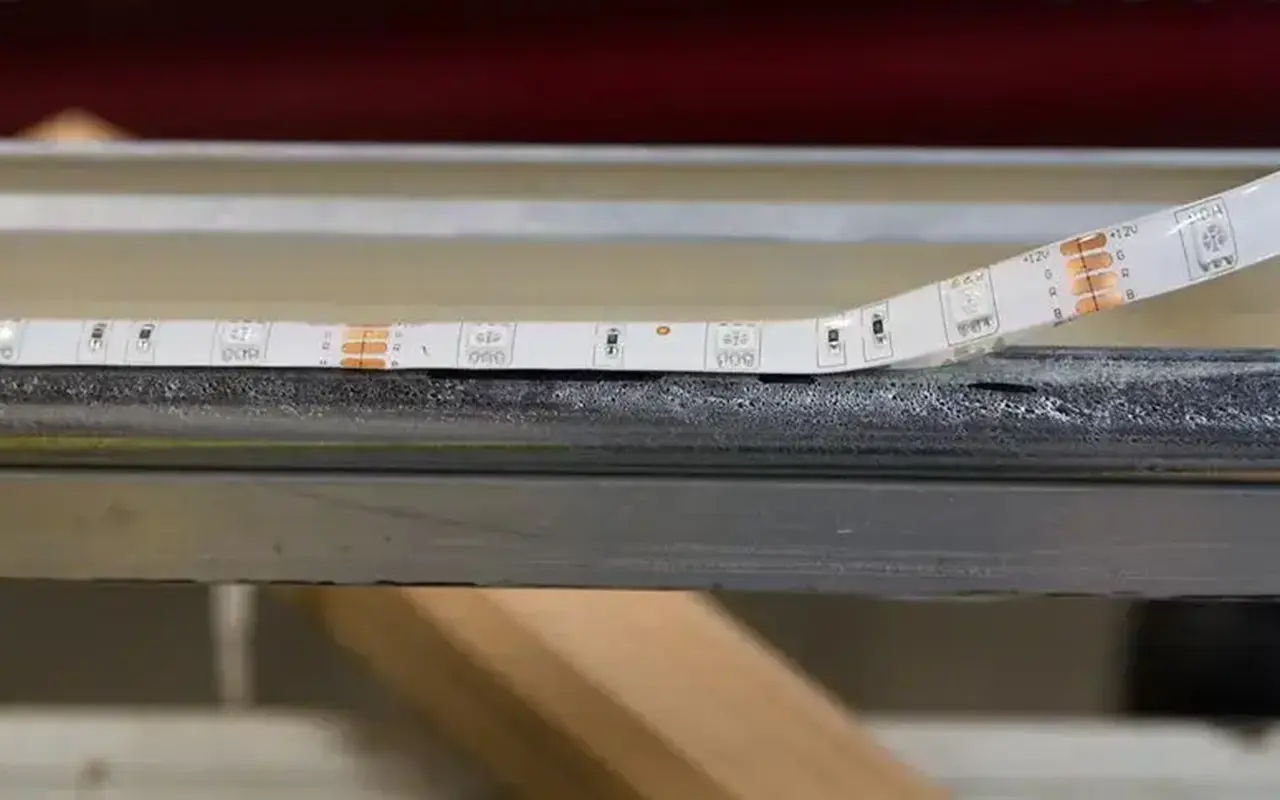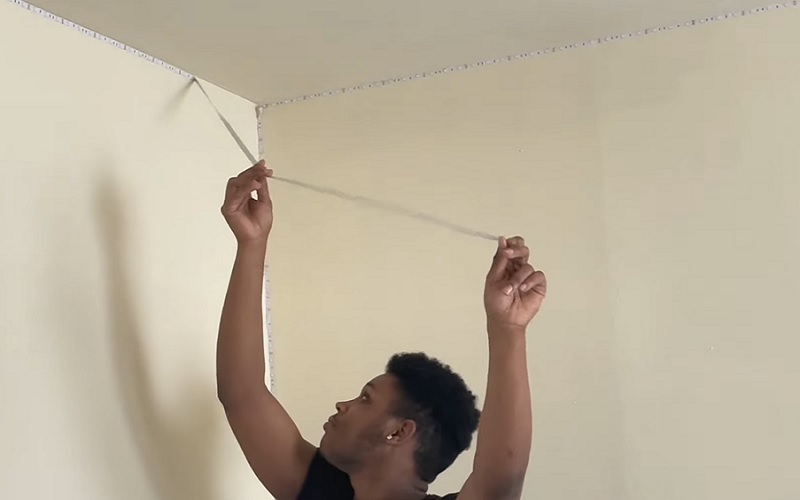To remove LED strip lights adhesive, use a heat gun or hairdryer to soften the adhesive while gently peeling off the strip.
Contents
Preparation
Preparation is essential before attempting to remove adhesive from LED strip lights.
This stage ensures that you have everything you need and creates a suitable work area to make the process as smooth as possible.
In this section, we will discuss the necessary tools and how to set up your work area effectively.
Gathering Necessary Tools
Before beginning the adhesive removal process, it’s crucial to gather all the necessary tools. Having these tools on hand will make the task much easier and efficient.
Here is a list of the essential tools you’ll need:
- Heat gun or hairdryer
- Isopropyl alcohol
- Microfiber cloth or sponge
- Razor blade or plastic scraper
- Cotton swabs
Creating A Suitable Work Area
Creating a suitable work area is crucial for the safe and effective removal of adhesive from LED strip lights.
Here are some steps to set up a proper work area:
- Choose a well-lit and well-ventilated area to work in.
- Ensure the surface is clean and free from any debris or obstructions.
- Cover the work area with a protective layer such as a plastic sheet or old newspaper to catch any adhesive remnants.
- Keep all the necessary tools within easy reach to avoid interruptions during the process.

Methods For Removing Adhesive
Peeling the adhesive off by hand is a straightforward method. Heat is also effective in softening adhesive, making it easier to remove.
Chemical Solutions
When it comes to removing LED strip lights adhesive, chemical solutions can be an effective method.
However, it’s essential to choose the right adhesive remover and follow the necessary application and safety precautions for optimal results.
Choosing The Right Adhesive Remover
Before embarking on the removal process, it’s crucial to select a suitable chemical adhesive remover. Consider the type of adhesive used and opt for a remover specifically designed to work with that adhesive.
Ensure to read the product label and choose an adhesive remover that is safe for the surface the LED strip lights are attached to, whether it’s metal, plastic, or wood.
Application And Safety Precautions
When using chemical solutions to remove LED strip lights adhesive, it’s important to follow certain application and safety guidelines. Prioritize good ventilation in the area where the adhesive remover will be applied.
Wear gloves and protective eyewear to prevent skin or eye irritation. Read the manufacturer’s instructions carefully and apply the adhesive remover as directed. Avoid overusing the product, as it can potentially damage the underlying surface.

Mechanical Removal
To remove LED strip lights’ adhesive, use a mechanical removal method. Gently pry the lights using a plastic scraper, working in small sections.
Apply heat to soften the adhesive for easier removal. Clean the surface with adhesive remover for a smooth finish.
Using Tools Like A Paint Scraper
To effectively remove the adhesive from your LED strip lights, mechanical removal is a tried and tested method. One effective tool you can use for this purpose is a paint scraper.
The sharp edge of a paint scraper can help you gently lift and scrape away the stubborn adhesive without damaging the surface.
Here’s how you can use a paint scraper to remove the adhesive from your LED strip lights:
- Start by positioning the paint scraper at a slight angle against the adhesive.
- Gently apply pressure and move the scraper back and forth, working your way along the adhesive.
- Be careful not to press too hard to avoid damaging the surface underneath.
- Continue scraping until the adhesive is fully removed.
- For stubborn adhesive, you can also try heating it with a hairdryer to make it more pliable before scraping.
It’s important to note that you should always proceed with caution when using a paint scraper to avoid any accidental damage. Taking your time and using gentle pressure will help ensure a smooth and successful removal process.
Avoiding Damage To The Surface
While using a paint scraper can be effective in removing adhesive from LED strip lights, it’s crucial to take precautions to avoid any damage to the underlying surface.
Here are a few tips to help you safely remove the adhesive while preserving the integrity of the surface:
- Before scraping, test a small, inconspicuous area to ensure the surface can withstand the scraping process without getting scratched or damaged.
- Apply a small amount of adhesive remover or rubbing alcohol to the adhesive. This can help loosen it and make the scraping process easier.
- Use a light touch when scraping. Applying too much pressure can result in scratches or gouges on delicate surfaces.
- If the adhesive persists, consider using a plastic scraper instead of a metal one to reduce the risk of damage.
By following these tips, you can safely remove the adhesive from your LED strip lights without compromising the appearance or condition of the surface.
Removing the adhesive from your LED strip lights can be a meticulous process, but with the right techniques and tools, you can achieve clean and adhesive-free lights.
Using a paint scraper and being mindful of the surface you are working on will help you successfully tackle this task. So, grab your paint scraper, apply these tips, and say goodbye to those stubborn adhesive residues!
Cleaning The Surface
To remove LED strip lights adhesive, start by gently heating the adhesive with a hairdryer.
Then use a putty knife or plastic card to scrape off the adhesive.
Afterwards, clean the surface with rubbing alcohol or adhesive remover to remove any remaining residue.
Removing Any Residue
If you’ve just removed your LED strip lights, you might find that there is some adhesive residue left on the surface.
This residue can be stubborn and difficult to remove, but with the right approach, it can be easily taken care of.
- Prepare the surface: Before you begin, make sure the surface is clean and free from any dust or debris. Use a dry cloth to wipe away any loose particles.
- Apply a solvent: There are various solvents that can help loosen the adhesive residue, such as rubbing alcohol, white vinegar, or adhesive remover. Apply a small amount to a soft cloth or sponge.
- Gently rub the residue: With the solvent-soaked cloth or sponge, gently rub the residue in a circular motion. Apply slight pressure without damaging the surface. This will help break down the adhesive.
- Continue until clean: Repeat the rubbing motion until all the residue is removed. You may need to reapply the solvent and use a fresh cloth if the residue is particularly stubborn.
- Clean the surface: Once the residue is gone, wipe down the surface with a clean, damp cloth to remove any remaining solvent or residue. Make sure to dry the surface thoroughly afterward.
Restoring The Surface
After removing the adhesive residue, it’s essential to restore the surface to its original condition. This will ensure that the new adhesive or any other decorative elements adhere properly.
- Buff the surface: Use a soft cloth or sponge to gently buff the surface. This will help remove any remaining particles and smooth out any imperfections.
- Inspect for damage: Take a close look at the surface to check for any damage or scratches caused during the removal process. If you notice any, you may need to repair or repaint the surface.
- Apply a primer (if necessary): Some surfaces may require a primer before applying a new adhesive or any other decorative elements. Check the manufacturer’s instructions or consult a professional for guidance.
- Follow instructions for new adhesive: If you plan to reapply LED strip lights or any other adhesive, make sure to follow the instructions provided by the manufacturer. This will ensure a secure and long-lasting bond.
- Take preventive measures: To avoid future adhesive residue, consider using removable adhesive strips or hooks. These can be easily removed without leaving any residue behind.
Post-removal Care
Once you have successfully removed the adhesive from your LED strip lights, it is crucial to take proper care to ensure they remain in good condition.
Follow these steps to inspect for any damage and prevent adhesive residue in the future:
Inspecting For Any Damage
- Check for any bent or damaged sections on the LED strip lights.
- Ensure the lights are functioning properly before re-installing them.
- If there are any visible damages, consider replacing the affected parts.
Tips To Prevent Adhesive Residue In The Future
- Before applying new adhesive, clean the surface thoroughly with rubbing alcohol.
- Allow the surface to dry completely before attaching the LED strip lights.
- Invest in high-quality adhesive that is specifically designed for LED lights.
- Avoid exposing the lights to extreme temperatures to prevent adhesive failure.
Frequently Asked Questions Of How To Remove Led Strip Lights Adhesive
How Do You Get Sticky Residue From Led Lights Off The Wall?
To remove sticky residue from LED lights off the wall, use a mixture of warm water and mild dish soap.
Apply the solution with a soft cloth and gently scrub the affected area. Rinse with clean water and dry with a towel.
Avoid using harsh chemicals to protect the wall’s surface.
Can You Remove And Restick Led Lights?
Yes, you can remove and restick LED lights without damaging them. Use caution to preserve the adhesive backing for reinstallation.
Do Led Strips Peel Off Paint?
LED strips do not peel off paint as they use adhesive backing that is specifically designed to be safe for most surfaces.
However, it is always recommended to test a small area first, especially if the surface has delicate or sensitive paint.
How Do You Get Led Strips Off The Wall?
To remove LED strips from the wall, carefully peel off the adhesive backing and gently pull. Clean residue using rubbing alcohol.
Conclusion
If you’re struggling with removing LED strip lights adhesive, these tips can help you. Always start by loosening the adhesive gently and then using a heat source for removal.
Remember to clean the surface thoroughly afterwards. By following these steps, you’ll have your adhesive-free LED strip lights ready to go!

